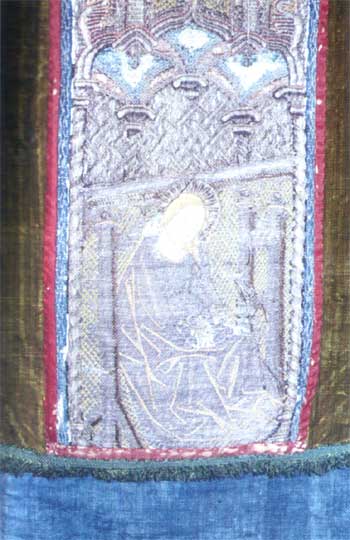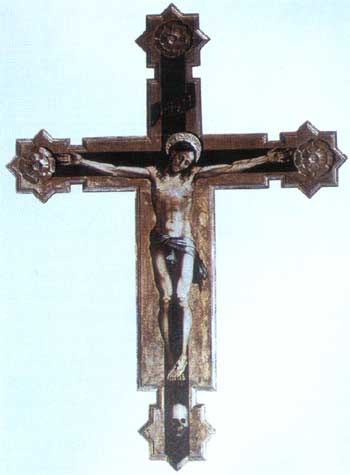Conventual
Church, Valletta, may also be a survivor of the fire. It carries
five splendidly realised Passion scenes. This is an early sixteenth
century Flemish work of high quality which, in spite of being
trimmed to make it conform to Council of Trent specifications,
has been spared the serious mutilations of the Vittoriosa set.
|
|
| Museum of the Vittoriosa
Collegiate Chapter. Detail of chasuble with images from
the Life of the Virgin. Silk, and gold and silver thread
embroidery. Photo credit: Dr Mario Buhagiar. |
A monumental oils on wood Crucifix, now generally recognised
as a work by Polidoro Caldara da Caravaggio (1492-1543), may
have replaced a Rhodian icon that perished in the fire. It seems
to have been commissioned in Messina, where the artist settled
after fleeing from the Sack of Rome of 1527, and remained in
Birgu until |
around 1578 when it was moved to
the new conventual church in Valletta (13).
Whatever its history, the painting testifies to the discerning
patronage of the Knights in the earliest phase of their Maltese
period.
A painting of St. Lawrence Enthroned, which until around 1689
served as the main altarpiece of the Birgu church (14),
has been repeatedly proposed as a survivor of the Rhodian treasure.
The date 1532, discovered when the painting was restored and
transported to a canvas support in 1937, would, however, seem
to indicate otherwise. The probability is that, as in the case
of the Polidoro Crucifix, it was commissioned to replace a lost
Rhodian icon. The painting, which could have been the central
panel of a dismembered polyptych (15),
carried the arms of the Master Villiers de l'Isle Adam, and
was worked in a tempera technique on a panel composed of six
vertically arranged timber planks. It was de
|
|
| Polidoro Caldara da Caravaggio,
Crucifix. Oils on panel. Conventual Church of St. John,
Valletta. Photo credit: The Marquis Cassar de Sayn. |
|
|
[13] M. Buhagiar,
"Paintings", in J. Azzopardi, op. cit., 25-26.
[14] It was replaced by Mattia Preti's giant altarpiece of
the martyrdom of St. Lawrence.
[15] Two possible side panels were recorded in 1937 (G. Porsella-Flores,
"An old picture of St. Lawrence", The Daily Malta Chronicle,
30.x.1937). They were destroyed at the same time as the painting. |
|

